

This morning, after a leisurely breakfast, we reboarded our buses for a guided "panoramic" tour around Paris. We stopped at the Champ de Mars, a park in front of the military academy (whence the name, "Field of Mars," the war god), for a good view of the Eiffel tower. This monument, which I think was the tallest tower in the world when new, was constructed for the 1889 centennial of the start of the French Revolution; it has since gained dozens of feet of height from TV transmission antennae. It was the first monument constructed using "naked" steel, which up to that point was considered an industrial material to be hidden under more dignified substances like stone for public edifices; not long after it was built, several prominent artists and architects petitioned for it to be demolished. Fortunately, the petition was not granted, and today it is the most visited monument in France.
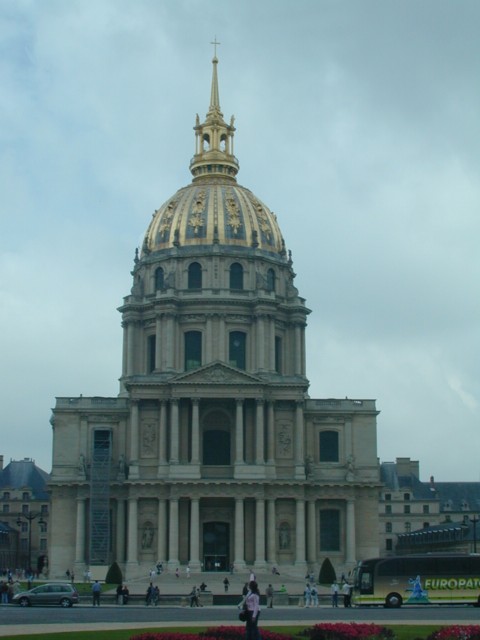
We saw numerous other famous sites from the buses; we'll visit some of them together later, and will have to return to the rest on our own time (I'm drawing up my plans for Monday). This is the church attached to the Hôtel des Invalides, the home for disabled soldiers that was founded by Louis XIV. About half of the Sun King's 72-year reign was spent at war, so this vast complex was built to take care of wounded veterans. Napoleon converted the church to a military mausoleum, a resting place for the greatest marshals of France, and (some decades after his death) he was buried here himself.
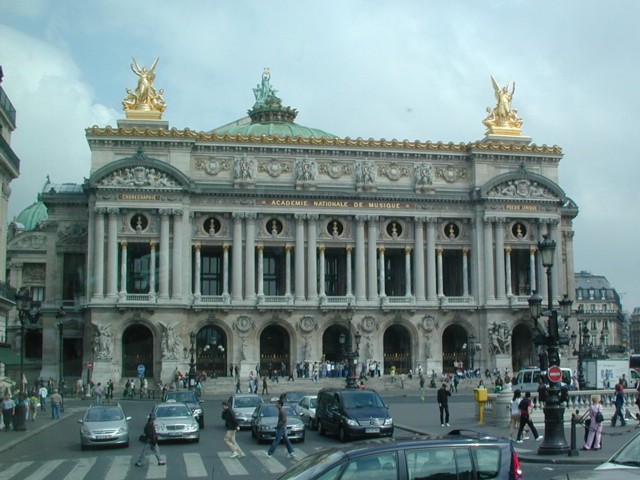
This is the Opéra Garnier, which we'll tour tomorrow (and where many of us will see a show Monday night). This section of Paris was rebuilt during the latter half of the 19th century, during the Second Empire under Napoleon III; he was inspired by the rebuilding of London after a great fire, and sought to create a modern city with broad avenues in place of narrow, sinuous medieval streets. The rebuilding centered around the railway stations, the modern "bridges" into the city; thus you will find medieval structures still standing mostly in districts remote from the railway stations.
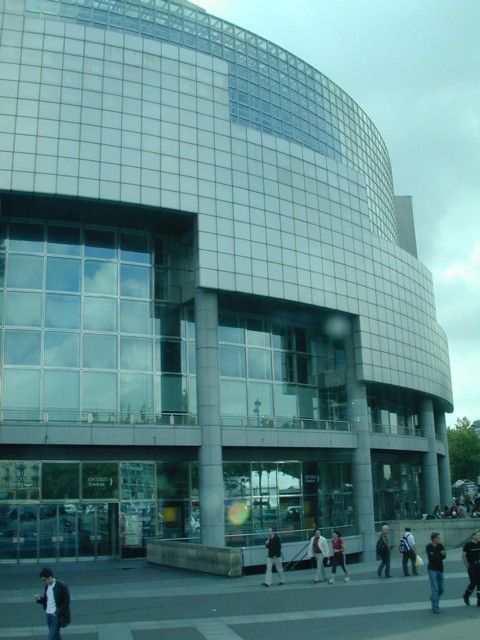
For the bicentennial of the Revolution in 1989, the very different Opéra de Paris Bastille was built in the Place de la Bastille. The Bastille was a fortress where political prisoners were once kept, and its storming on July 14th (now celebrated annually as Bastille Day) in 1789 touched off the Revolution. At the time, there were no political prisoners there, just seven common criminals and fourteen guards; however, the revolutionaries wanted to liberate something even more essential: the gunpowder stored there.
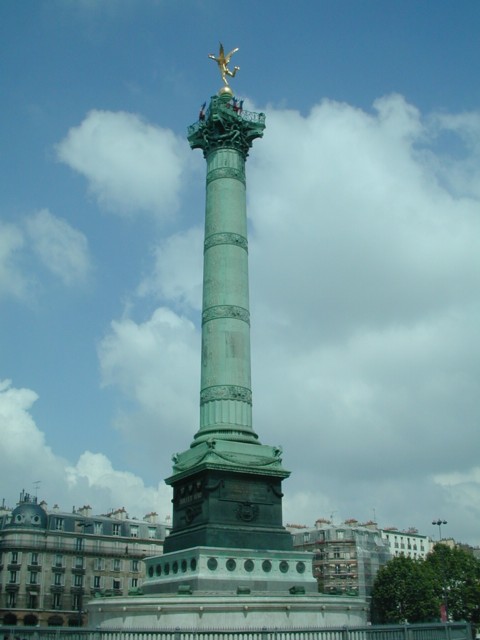
The Bastille fortress no longer exists; it was demolished by the revolutionaries. At the Place de Bastille where it once stood is this column erected in honor of the 1830 revolution, one of three uprisings during the 19th century.
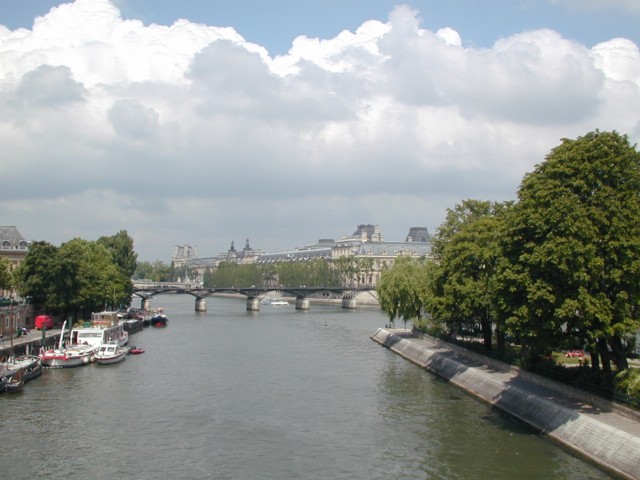
The most ancient part of Paris is on the Île de la Cité, an island in the river Seine. I took this photo from the bus as we crossed the Pont Neuf, the "New Bridge" that is the oldest surviving bridge over the Seine; you can see the tip of the island to the right, and in the distance the vast Louvre museum.
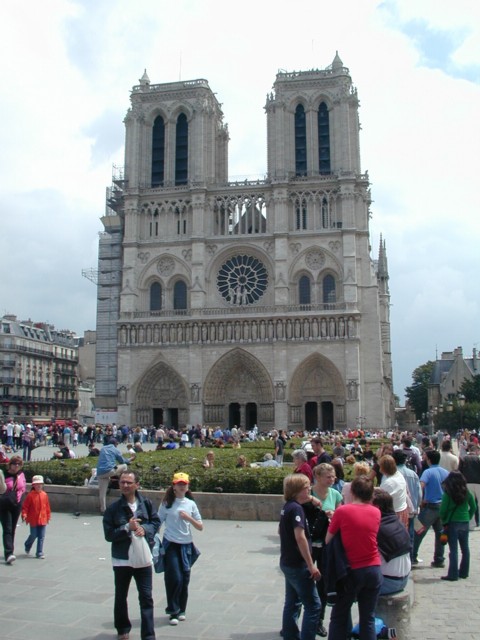
We got off the buses to walk to the Cathedral of Notre Dame (Our Lady) on the Île de la Cité. As with other churches we've visited that were saved from demolition after the Revolution by being used as a stable (Les Jacobins in Toulouse) or as a prison (Fontevraud), Notre Dame was used as a city warehouse. As with the others, it was pretty badly damaged in the process; e.g., only the rose windows at the north, west, and south are originals. The phenomenal success of Victor Hugo's novel "The Hunchback of Notre Dame" in the 19th century led Parisians to "rediscover" their cathedral, as our guide phrased it, and to undertake renovations.
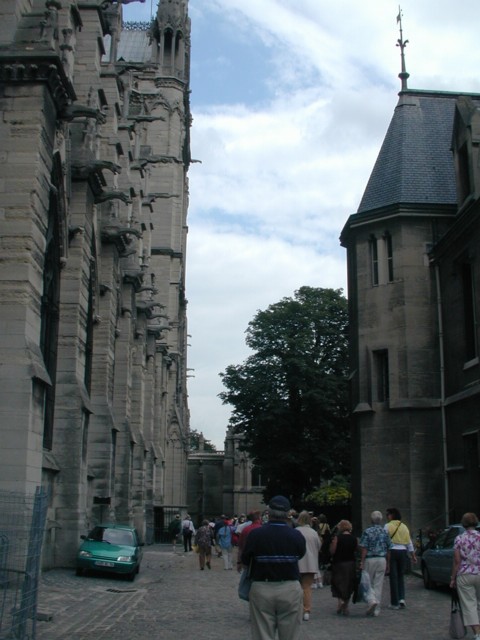
Before we began our guided tour of the cathedral, we stopped to have a rehearsal in the place where we will sing at Mass tomorrow morning. Here we are walking in to a side door under the watchful gaze of dozens of gargoyles.
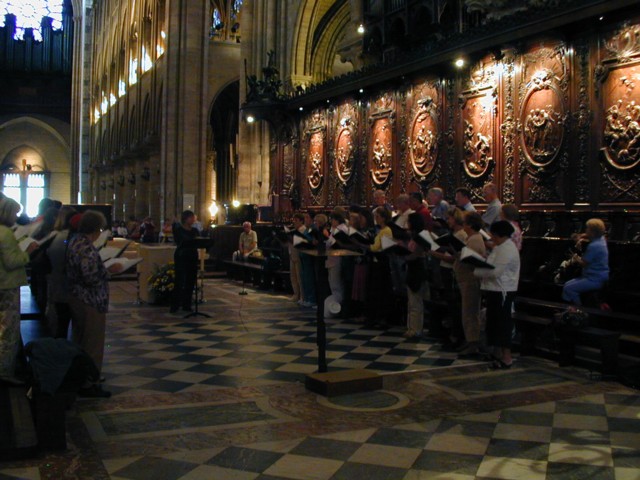
I have referred previously to the "choir" of a medieval church, which is the section in the middle where the arms of the cross-shape of the church meet; I had understood that this is not usually where a "choir" in the modern sense, i.e., us, would sing, but that is where we will be tomorrow. (Thanks again to Steve Campbell for this photo.) To the left you can look down the nave toward the main entrance, with the rose window at the upper left corner; right under that is the cathedral's great organ. Lee will not be playing that while we sing; rather, we rehearsed with her at a smaller (but still very nice-sounding!) organ above the choir. She sat at our level, and you can see the base of the pipes at the top of the photo above the large carved wooden screen. This arrangement allowed us to hear each other much better than we could yesterday at Chartres!
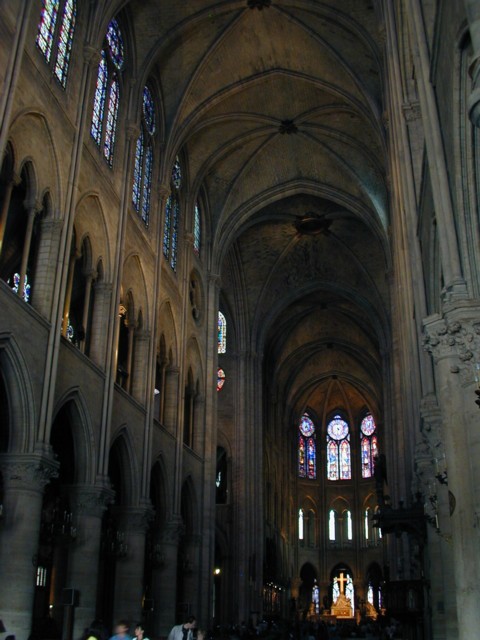
The "Gothic" style of cathedral is the national style of France; the name was actually applied pejoratively by Italians, whose ideals of architectural beauty were rooted in ancient Roman and Greek structures, and who gave the name of a barbarian tribe to a style that they found distasteful. Their loss! Notre Dame is a vast place, with five aisles in the nave (two outriders on either side of the main one). Here we are looking down the nave toward the apse at the eastern end; you can just see some baroque sculptures at floor level. These were donated by Louis XIII, who had no children in the first 22 years of his marriage, in gratitude for the birth of his son who became Louis XIV, the Sun King; actually, they were finished posthumously so it was really Louis XIV who saw them installed. The statues depict the two kings kneeling and offering their crowns to the Virgin Mary. I didn't mention it yesterday, but in Chartres Mr. Miller, our guide, said that he found the baroque statue in the apse of that cathedral to be jarringly out of place in a Gothic cathedral; certainly the styles contrast...
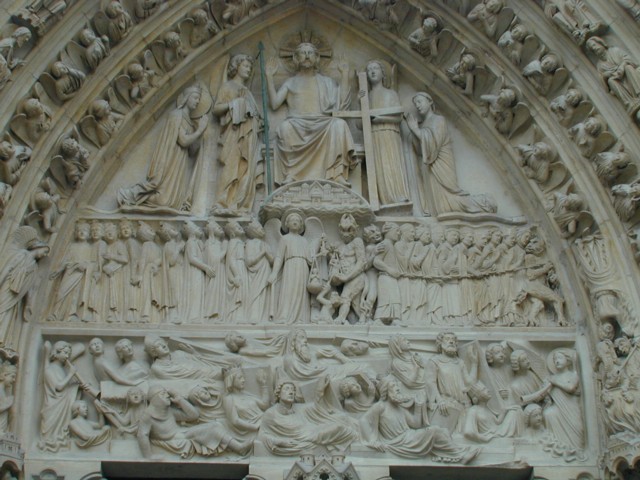
Unfortunately, our tour of Notre Dame was even more hasty than our look at Chartres yesterday; our guides pointed out several "pages" in the "book" that is a medieval cathedral, and I wanted to show at least one. This is the sculpture above the main entrance; it shows Christ seated at the Last Judgment. Below Him on the left ("at His right hand") are the resurrected souls on their way to Heaven, and on the other side are the damned being dragged off to Hell by a demon with a chain. Note that between the two groups is an angel holding the scales of judgment; Satan is pushing down on his side of the balance, hoping to steal a few more souls to carry off!
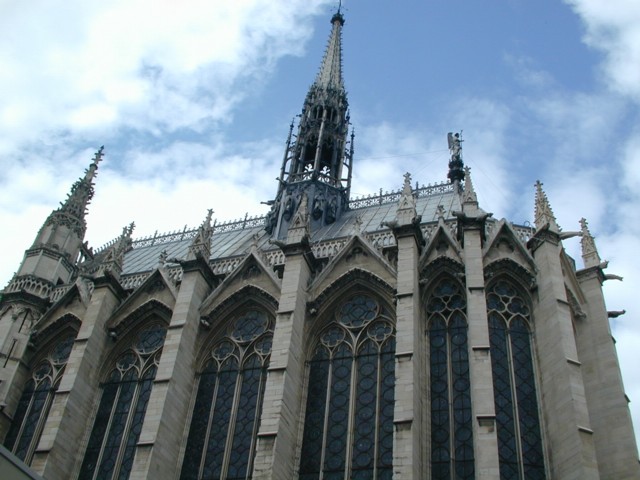
Next we walked to the Justice Department complex and passed through a security screening, then went inside to see Sainte Chapelle. The reason this church is inside the security perimeter is that the buildings used by the Justice Department are on the site of the first royal palace in Paris, with Sainte Chapelle (which I think simply means "Holy Chapel") being the only survivor of the original buildings. (The Louvre was originally constructed as a fortress to defend the city while the King was away at the Crusades; when he returned, it became the second royal palace, and the first was converted into a prison, which I guess is how it came into the keeping of the Justice Department.) Note the narrowness of the external buttresses; this is not as tall a church as the cathedrals of Chartres or Notre Dame de Paris, but even so they seem disproportionately small.
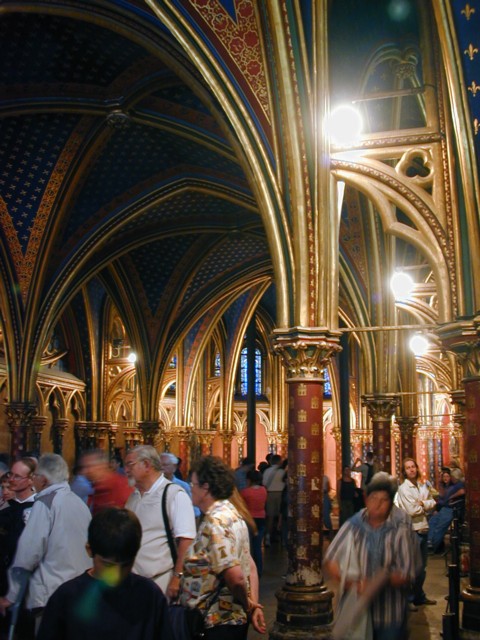
Part of the reason can be seen here, on the lower of two levels: there are internal flying buttresses. There is also a "strap" of iron running around the midlevel of the windows which I understand is also part of what holds the building together, though it sure looked to me like it was too narrow to exert much force. This lower level is where courtiers would attend mass; the upper level was reserved for the King. And for the servants who cleaned the place; we walked up on staircases that they would have used. The colorful decorations are from a 19th-century restoration, and include the fleur-de-lys of King Louis IX and the castle of his mother Blanche of Castille.
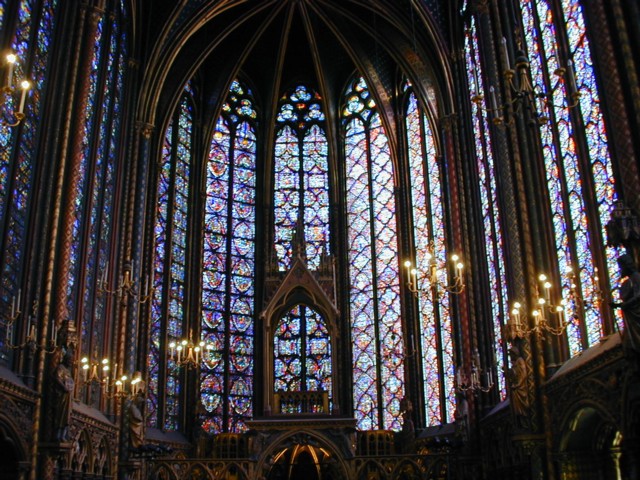
This view of the upper chapel shows why the architect expended so much effort to keep the external buttresses narrow: the chapel reserved for the King (and the servants) appears to be made of almost nothing but stained glass. The goal of the Gothic style was to have a church consist of pure light, with as little stone as possible; an early Gothic structure like the Cathedral of Notre Dame had more window area than a Romanesque structure, but if you compare the photo of the interior of Notre Dame a few pictures up with this one, you can see that this later development was light-years ahead (pardon the pun). The small structure at the center of the photo is where the reliquary would have been housed; the most precious relic here was a crown of thorns that was said to be the one the Romans put on Jesus' head before they crucified Him. Each year on Good Friday the King would have unlocked the reliquary and taken out the crown of thorns to show the people outside (I gather the windows could be opened in that part of the chapel). Louis IX purchased the relic from the Emperor of Byzantium; it cost him more than twice what it cost to build Sainte Chapelle itself. Over time the thorns have been removed from the crown to be given as gifts to other kings or placed in reliquaries in other churches; the other relics of Sainte Chapelle were destroyed during the Revolution, but the crown of thorns survived and now resides at Notre Dame. (Even the most precious relic at Chartres, the robe Mary wore when she gave birth to Jesus, was torn in two during the Revolution.) Sainte Chapelle escaped demolition after the Revolution by being used as an archive; construction of shelving caused the removal and subsequent loss or sale of about the lower third of the windows, but the rest are original 13-century work (with the exception of the rose window behind the camera here, which is a 15th-century replacement). Given the virulence of the anticlerical feeling of the revolutionaries, I'm glad that so many of these ancient holy places survived to be renovated in the 19th century! France, and all of us who visit here, would be poorer had they not.
 To
Sunday, 10 July 2005
To
Sunday, 10 July 2005 Back
to choir tour itinerary
Back
to choir tour itinerary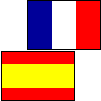 Back
to choir tour home page
Back
to choir tour home pagenew 9 July 2005